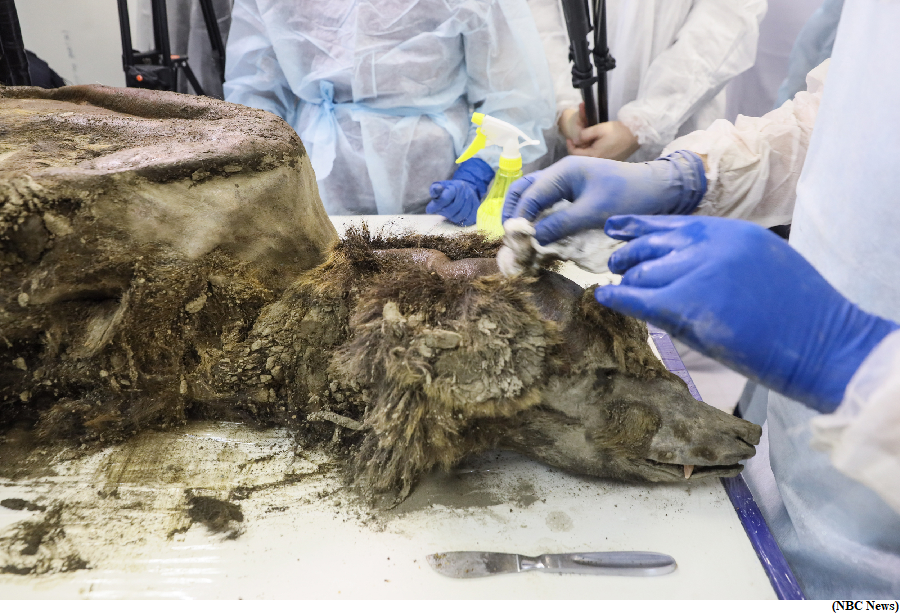Scientists dissect 3,500-year-old bear discovered in Siberian permafrost (GS Paper 3, Science and Tech)

Why in news?
- A brown bear that lay almost perfectly preserved in the frozen wilds of eastern Siberia for 3,500 years has undergone a necropsy by a team of scientists after it was discovered by reindeer herders on a desolate island in the Arctic.
Etherican brown bear:
- The female bear was found by reindeer herders in 2020 jutting out of the permafrost on Bolshoy Lyakhovsky Island, part of the New Siberian archipelago around 4,600 km east of Moscow.
- Because it was found just east of the Bolshoy Etherican River, it has been named the Etherican brown bear.
- The extreme temperatures helped preserve the bear's soft tissue for 3,460 years, as well as remains of its final repasts - bird feathers and plants.
- The bear is described as being 1.55 metres (5.09 ft) tall and weighing nearly 78 kg (172 pounds).
How dissection was done?
- They cut through the bear's tough hide, allowing scientists to examine its brain, internal organs and carry out a host of cellular, microbiological, virological and genetic studies.
- The pink tissue and yellow fat of the bear was clearly visible as the team dissected the ancient beast.
- They also sawed through its skull, using a vacuum cleaner to suck up the skull bone dust, before extracting its brain.
Observations made:
- Genetic analysis has shown that the bear does not differ in mitochondrial DNA from the modern bear from the north-east of Russia – Yakutia and Chukotka.
- The bear was probably aged about 2-3 years. It died from an injury to its spinal column.
Significance:
- The Lyakhovsky islands contain some of the richest palaeontological treasures in the world, attracting both scientists and ivory traders hunting for woolly mammoths.
- For the first time, a carcass with soft tissues has fallen into the hands of scientists, giving us the opportunity to study the internal organs and examine the brain.
Kerala becomes first state to use robotic scavengers to clean manholes
(GS Paper 2, Governance)
Why in news?
- Recently, the Kerala government launched robotic scavenger, Bandicoot, to clean sewages in this temple town, becoming the first state in the country to use robotic technology to clean all its commissioned manholes.
- Water Resources Minister, launched Bandicoot under the Guruvayur Sewerage Project in Thrissur district by the Kerala Water Authority (KWA), as part of the 100-day action plan of the state government.

How Bandicoot works?
- The robotic Tron Unit, which is the major component of Bandicoot, enters the manhole and removes sewage using robotic hands, similar to a man's limbs, the release, adding that the machine has waterproof, HD vision cameras and sensors that can detect harmful gases inside the manholes.
- Bandicoot, developed by Kerala-based Genrobotics, had recently bagged 'Kerala Pride' award at the Huddle Global 2022 conclave organised by Kerala Startup Mission (KSUM).
Significance:
- Genrobotics, a Technopark-based company, have developed "the world's first robotic scavenger" Bandicoot in an effort to eliminate manual scavenging providing respite for workers engaged in manhole cleaning.
Way Forward:
- Bandicoot will be cleaning all the commissioned sewerage and drainages in Kerala.
- Bandicoot robots are currently deployed in few towns across 17 states in India and three Union Territories. In 2018, KWA started using Bandicoot to clean the manholes in Thiruvananthapuram. Later, it was introduced in Ernakulam also.
Bihar cabinet approves $50,000 for developing fog alert system with US-NCAR
(GS Paper 2, Governance)
Why in news?
- Recently, the Bihar cabinet approved USD 50,000 for developing an early warning system for dense fog and cold wave conditions in collaboration with the US National Center for Atmospheric Research (US-NCAR).
- The cabinet approved USD 50,000 (about Rs 41.41 lakh) for technical support of the works that will be jointly carried out by the state government and US-NCAR.

Early warning systems:
- Early warning systems are key elements of climate change adaptation and disaster risk reduction, and aim to avoid or reduce the damages caused by extreme weather conditions.
- The Bihar Mausam Seva Kendra (BMSK) is developing an app through which early warning for dense fog and cold wave conditions will be provided to the people.
- Besides, information regarding this will also be provided to the people through the call center of the BMSK.
What’s next?
- A Memorandum of Understanding (MoU) will soon be signed between the state government and NCAR.




